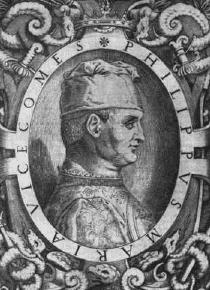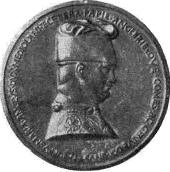Arguments for 1428
How does players behave? Are they interested all their life in the same game or in the manner of playing games at all? Being an intensive player myself with much opportunity to observe other players in their behaviour, I would conclude, that only few players are obsessed all their life, they've phases, in which they indulge in games evening after evening, living the game in excess, and then they have also years, in which they do not play games at all. Under players there are exceptions of this rule, but - normally - there are just hot phases, mostly depending, if you've the right partners for playing at hand. You need a group ...From our observations about Ferrara we assume that there was a hot playing card phase in the time of Parisina 1422 - 1424 , and actually we assume a hot phase perhaps for all Italy in these years, which followed the council of Constance (an occasion, at which many Italians experienced German playing card freedom).
And there was a counter-reaction, the preacher San Bernardino organised masses of people against various modernisations in society, and it seems, that he was not totally successless, cause in the late 20ies, early 30ies of 15th century we do not hear very much about playing cards in Italy. This negative development was a little overcome in the late 30ies, finally seems to have diappeared in the 50ies (card playing has a peak) and from Italian playing card prohibitions we do not hear much (in 1454 started the peace of Lodi and this seems to have had a good influence upon playing card development, the society was released - this development is also mirrored by the freedom in art, Greek gods start to be en vogue now). Also we observe in Ferrara, that the courtly Trionfi card production seems to finish in 1463 - a very strange fact, who is difficult to explain, cause this seems to be not a general phenomen relatable to the global situation. In my opinion it just reflects the personal condition of the court: Duke Borso is old enough to stop playing (his interest has reached a limit, see above: the development of players) and there are not very much young people at the court, which keep the interest alive.
What about Filippo Maria Visconti? We know, that he produced the Michelino deck in the time between 1417 (until then Michelino da Besozzo worked not in Milano) and 1425 (Martianus da Tortona is definitely dead). We've the suspicion, that we should favour the date 1424 - in this year:
- Filippo Maria was military successful and has optimistic perspectives for the future.
- Filippo Maria received visit from the Greek Emperor in this year (the Michelino deck reflects the Greek Olymp, and it's a riddle, how Filippo reached this theme far before all the other Italian development in art - the Greek Emperor might have brought this idea to Filippo)
- Filippo Maria had much contact to Carlo Malatesta, who was as a well-treated prisoner since July 1424) at his court and finally was released with many presents in early 1425; Carlo Malatesta was in Germany 1414 at the council of Constance and we've the suspicion, that he imported from there an interest to playing cards to his own court, which resulted in the playing card addiction of the young Parisina, who seems to have imported that interest to Ferrara after her marriage in 1418 to Niccolo, the much older Marchese. Carlo might have raised the card playing interest in Filippo, also it is observable that the general rather lonesome Filippo enjoyed especially the presence of highstanding guests with good education, which had a similar social level. The communicative situation was repeated in 1435, when Alfonso of Aragon was - also as a prisoner - at the court of Filippo. He was treated well, finally and surprizingly to all others released - as Carlo Malatesta - and it is said, that Alfonso and Filippo played cards. The actions from 1424 - visit of the (later) Greek Emperor and "visit" of Carlo Malatesta - are a very personal riddle for Filippo Visconti, cause the Greek Emperor is the husband of Filippo's earlier wife and Carlo Malatesta also had some personal involvement with the Greek Emperor's familiy. (This theme is complex and demands further investigation and we will present it in a special article.)
- Filippo Maria must have gotten in late 1424 the news, that he will become father (birth of Bianca Maria in April 1425). This news must have released him from the secret fear that he might be not able to produce a heir. And in 1424 he didn't know, that Bianca Maria was "only" a girl.
-
Filippo arranged for himself a triumphal procession in 1425, probably due to his militaric
successes in the past and also the birth of Bianca Maria. Unluckily we don't have a
precise date.
1425 sees the height of the life of Filippo Maria Visconti. In late 1425 the war with Venetia started and with interruptions it determined a more or less negative phase for all Northern Italy for the next 30 years. The first war in the series (1425-1426) ended with losses for Filippo Visconti. - Filippo Maria had a first, probably never consumated marriage with Sophia of Montferrat (later wife of John Palaiologus), which was annulled in 1411 in a phase, when the dukedom of Milano was dominated by Ficino Cane (and Filippo Marias prospects looked rather bad). In the year 1412 Ficino Cane died, but Filippo was urged by the situation to marry the 20-years-older Beatrice de Tender, the widow of Ficino Cane. With her influence and money Filippo Visconti was able in the following years to reestablish the Visconti-reignment, however, the situation must have given him bad feelings, cause in 1418 he accused Beatrice de Tender of adultury and she ended beheaded. It's said, that Filippo started to live outside of public life in 1421 and one might assume, that this was a causal effect of the experience of 1418. However, this depressive behaviour, which took course during all his following life was perhaps a little broken up in 1424 and 1425. This more optimistic aspect of him during this special phase of life probably did lead also to the new marriage from 1428 with Maria of Savoia, which - in contrary to Beatrice de Tender - entered matrimony in very young years. Now Filippo had a much younger wife, around 20 years younger than himself.
From Niccolo d'Este it is known, that he had some understanding of chess. In the late 30ies and short before Niccolo's death in December 1441 it is said, that Niccolo had a good influence upon Filippo Visconti - probably he was one of very few, from whom this could be said, as also it is said, that Filippo avoided personal publical appearance; so there was perhaps no group to play with. Perhaps this good contact is a mystery between players - they just knew about a way to amuse with each other.
From all this it appears, that 1428 (near to 1424, 1427 and 1429) was a good date to produce the Cary-Yale. Especially the possibility, that the Cary Yale was intended as card game with contents of chess, deserves some attention (compare article). At other places (for instance the Ringmann-aricle) we already considered, that the idea to the Imperatori deck might have been connected to the game of chess. Here we do find a next hint, that there might have been a hidden relation.
Decembrio notes, that Filippo Maria never entered the bride's bed cause a dog howled in the wedding night. It's said, that Filippo Maria was superstituous in a high degree, so this special part of the story might be true, but also it might be, that Decembrio displayed just a common mockery to the later well known behaviour of the duke, letting his wife alone for around 19 years, and controlling her personal freedom in any way.
Decembrio also notes a special secret (probably sexual) vice of Filippo Visconti, which is occasionally interpreted in the way, that Filippo Maria was homosexuell. Or had a favour to very young girls, which had to read the "Canzonieri" of Petrarca.
Arguments for 1441
This is a much shorter argument, but it has an alarming content. One should keep in mind, that the Cary-Yale was considered often enough a deck, which served as present for the wedding of Francesco and Bianca Maria Visconti.Fact 1: In the year 1441 Francesco Sforza, * 1401, married Bianca Maria Visconti, * 1425. This means: A man of 40 years married a girl of 16 years in age, and he is with that 24 years older than she. Remember the numbers: 40 - 16 - 24.
Fact 2: The Cary Yale survived only in fragmentarious form. However, it is plausible, that it had originally 40 numbers and 24 court cards (an unusual court card number, and we know it only from this deck). Additionally there are 11 trumps and their true original number is a riddle. However, the most probable number seems to be 16 (see Cary-Yale-article). With that you have the same numbers as above: 40 - 16 - 24
Could that have happened accidently? It's not impossible, but unlikely. And Filippo Maria, a man, who was highly superstitious and fond of astrology and probably also of numerology, was the right man to look at such things.
1441 is also a very good date.
(autorbis)

